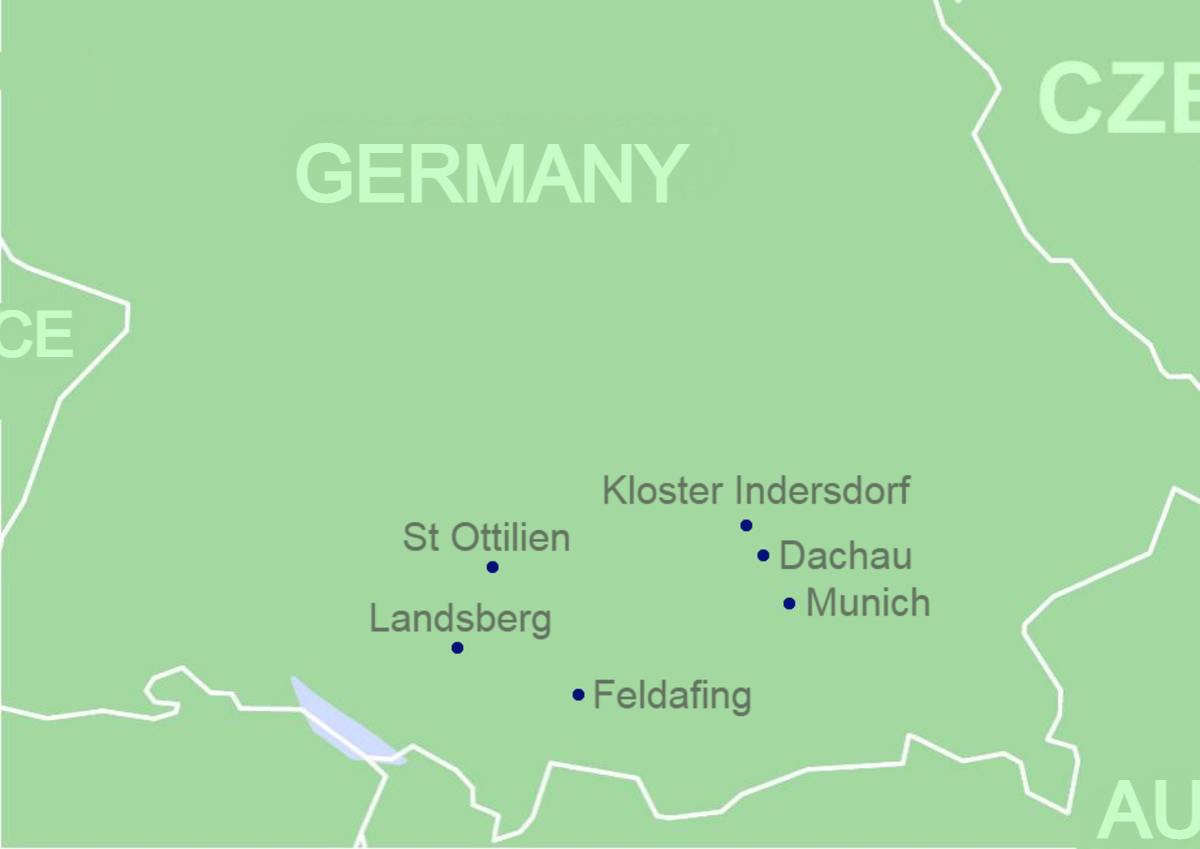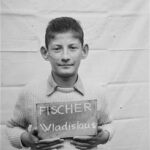Fifty of the Southampton Boys spent the months after the liberation at the children’s home that was set up in a 12th century convent, Kloster Indersdorf, in Markt Indersdorf in Southern Germany near to Dachau and the city of Munich. The home cared for both Jewish and non-Jewish orphans and was run by the United Nations Relief and Rehabilitation Administration (UNRAA).

UNRAA teams were attached to military divisions of the US Army but were completely taken aback by the scale of the refugee crisis. Unable to cope, it meant that many of the surviving Boys spent weeks in field hospitals and fending for themselves before they were finally offered care and support by the Americans.
Arrival of the Boys
The Kloster Indersdorf children’s home opened on 7 July 1945, over two months after the liberation of Dachau. It was run by one of the UNRAA units, Team 182.
Many of the Boys who spent time at Kloster Indersdorf had been liberated by the US Army whilst on a death march from the Flossenburg concentration camp to Dachau on 23 April 1945. Some spent time with the units that liberated them as the soldiers tried to help as best they could. Others had lived in abandoned houses and made a living stealing watches and bicycles and selling them on the black market. This group of the Boys arrived in Indersdorf in late August. They were all given hand-knitted white pullovers which they can be seen wearing in photographs taken later in the UK. The UNRAA team noted that they had a fierce loyalty to each other, and the sweaters symbolised their unity as a group, which coalesced around the leadership of Kurt Klappholtz.
Other future members of the Boys like Hans Nuemann, who had been liberated in Theresienstadt, made their way separately to Kloster Indersdorf and in Neumann’s case he had spent some weeks in the Deggendorf DP camp.
Care for the Boys
Every new arrival was examined by the medical team, deloused, and inoculated against typhus, smallpox, typhoid and diphtheria. Not all the Boys were keen to have the vaccinations and Jacob Hecht had to be held down by his friends.
The months that the Boys spent at Kloster Indersdorf were highly significant in their rehabilitation. A large Baroque hall was used as a dining room and meals were taken in groups at individual tables led by an adult, as the children had learn even the simplest table manners.
German was the lingua franca. Schooling was compulsory for children between the age of 5-16 years old but many of the older Boys attended the classes and training sessions. Kurt Klappholtz remembered boycotting two of the classes that were taught by anti-Semitic Polish teachers, who were themselves DPs.
The nuns who soon returned to the convent ran the farm and the laundry, cooked, and cared for the smallest children. The older children were encouraged to help with the housework and caring for the smaller children.
Recreation and sport were also important and there are photographs of the Boys playing ping pong and football.
Team 182 spent time listening to the children’s stories and not only asked about their wartime experiences but their life before the war, which many of the Boys said did much to restore their strength. They were encouraged to express their experiences in art and drama and re-enacted scenes from the camps in a play performed in front of General Eisenhower. Erwin Farkas, who went on to become a psychologist, said that he benefitted from telling his story repeatedly as it allowed him to distance himself from the trauma.
Although some of the Boys rejected their faith, others began to be drawn back to their religious traditions and customs. Manfred Heyman recalled that they celebrated Sukkot in the garden and fasted at Yom Kippur. The sisters at the convent respected the Jewish holidays and at Rosh Hosannah covered the crucifixes with bed sheets.
Travelling Home
All the children knew that if their relatives had survived that would try to make their way back to their homes. Although they were aware of the dangers involved and feared for their safety, Team 182 did not stop the children from going home. Lazar Kleinman went to Prague to see his sister who was ill in hospital but she died just before he arrived.
At first Team 182 thought that the children would be speedily repatriated, but the Boys’ journeys home made it clear that the Jewish children could not or would not return home. Before arriving at Indersdorf, Moshe Birnbaum had been beaten up by the people living in his former family house in the German city of Fulda, when he had arrived home immediately after the liberation.
The Photographs of the Boys
In September 1945, a newsreel team led by the director Hanus Burger arrived in Kloster Indersdorf and the footage he shot clearly shows a number of the Boys.
Then in mid-October 1945, photographs were taken of the children that were published in newspapers across the world in the hope that relatives might be found. They were taken by the well-known American photographer Charles Haacker. A bed sheet hung behind the children provided a neutral background and one of the Boys, Salek Benedict, had the idea of writing each of their names on a piece of wood in chalk so that their names featured clearly in each of their photos. Benedict would later become a successful graphic artist.
Visas for the UK
A list of 50 of the Jewish children who could travel to Britain on the Central British Fund scheme was drawn up, but names came and went on and off this list as relatives were found and the children were diagnosed with tuberculosis. The UNRAA staff falsified some of their dates of birth so they could join the transport to the UK. Finally, on 15 October there was tremendous excitement when the group were given their ID cards permitting them to travel to the UK.
The departure was far from straight forward and the first time the group arrived at Munich Airport they found that the planes were not ready, the second time they were delayed by fog and forced to return to the convent, this time accompanied by the group of Boys from the Feldafing DP camp. The third attempt to leave for the UK was thwarted when one of the trucks coming to collect the children had an accident and it was only on the fourth attempt that they finally boarded the planes. Before they left the Director of Team 182, Lillian Robbins gave each of the children a personal letter asking them to stay in touch, and many of the Boys corresponded with the team over the years that followed.
As they climbed aboard, most of the Boys had bread in their pocket but Martin Hecht had filled his with stones in the hope he could throw them down on to Germany during the flight.
The remaining Jewish children at Indersdorf hoped they would follow in a second transport that never materialised and in the months that followed they became increasingly demoralised until arrangements were made for them to settle either in Palestine or the USA.
Today, there is a small exhibition in the convent at Kloster Indersdorf that tells the children’s story.
Associated Boys:
- Auspitz, William
- Benedikt, Salek
- Berkovitz, Samuel
- Beserman, Moses
- Birnbaum, Moshe
- Brenner, Chaim
- Brenner, Zysel
- Buchführer, Alfred
- Fijalko, Josef
- Fischer, Wladislaus
- Fuchs, Joseph
- Fulop, Yeno
- Geller, Chaim
- Grussman, Sinaida
- Hecht, Martin
- Hecht, Jacob
- Heyman, Manfred
- Hitter, Imre
- Junger, Mozes
- Junger, Samuel
- Jussem, Nelly
- Kadysiewicz, Kive
- Kadysiewicz, Hil
- Kahan, Dezider
- Kampel, Fischel
- Klajman, Jankiel
- Klappholz, Kurt
- Klein, Miklos
- Klein, Erno
- Klein, Sandor
- Kleinman, Lazar
- Kuczer, Szmul
- Kusmiersi, Jacob
- Lichtenstajn, Josef
- Maisner, Abraham
- Meier, Bruno
- Meisels, Bela
- Munkacsy, Tibor
- Nasch, Bernat
- Neumann, Hans
- Rolnik, Natan
- Rottenberg, Pinkas Eliasz
- Schwartz, Otto
- Steinkeller, Moses
- Stroh, Peter
- Swinik, Aron
- Swinik, Chaim
- Topel, Mordechai
- Troper, Jankiel
- Warsaw, Abraham
- Weinstock, Roman
- Weinstock, Herman
- Weiss, Julius
- Witelsohn, Wolf











































